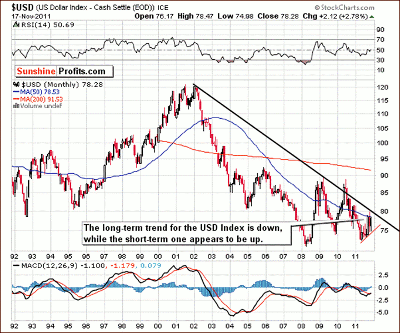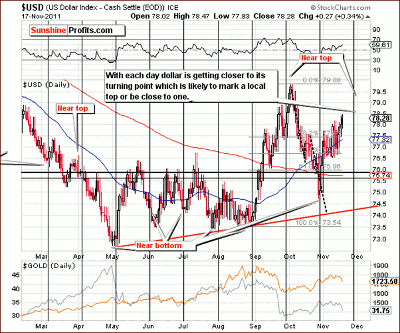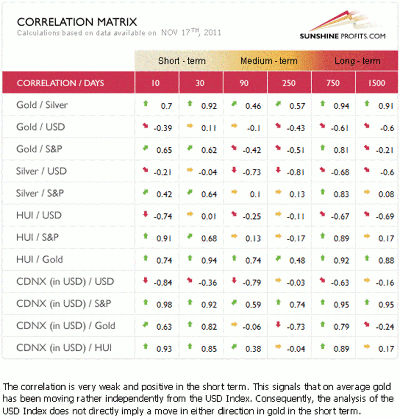P. Radomski of SunshineProfits.com explains how upcoming moves in the currency market will affect gold prices in December.
Analysts for Goldman Sachs have recently predicted that low interest rates will keep gold prices climbing for the rest of this year and into 2012 and raised their price forecasts for the precious metal to $1,930 per ounce from $1,860. So far this year, the price of gold is up about 26%.
Among other things, gold has been a beneficiary of the imploding euro. It’s simple physics, or economics, in this case. Money has to go somewhere.
Bonds of the smaller countries have been hit, stock markets have made little progress all year, and European banks have suffered losses over Greek debt, so there isn’t much choice left for investors. Some European money has crossed the Alps into Switzerland, always the continental safe haven of choice in turbulent times. But the Swiss have taken steps this summer to cap their currency to keep it from rising too quickly and destroying the attractiveness of their exports.
German bonds have also been a beneficiary, and the yield on the ten-year German bond has fallen to 1.7%, compared to 2008 when it was 4.5%. Germany is the stable, productive, responsible adult on the continent. But even Germany’s debt-to-GDP ratios don’t dazzle.
Right now, there seem to be three possible scenarios for the Eurozone that we can see, and all will be bullish for gold.
If the European Central Bank will begin start buying Eurozone bonds on a massive scale, printing money to the tune of trillions of euros to do so, the massive amounts of money flooding the market will inevitably push the price of gold up.
If, on the other hand, the Eurozone falls apart, one does not need much imagination to foresee the chaos that will ensue. Using the word “chaos” will be an understatement. Each country will have to introduce new currencies along with stringent capital controls to stop money from fleeing the country. Banks will collapse. We’re talking mayhem.
This is the kind of pandemonium that would be a boon for gold. For a while, gold could become the only credible currency left standing.
A third possibility is that the current mess with a flavor-of-the-week Eurozone crisis will drag on for a few more years. Last week, Mario Monti was selected to form a new Italian government. Monti, who is known in the Italian press as “Super Mario,” will have to face heroic challenges as he tries to steer his country from the brink of economic disaster.
Whatever the most recent crisis—and they seem to appear at an alarming rate of about one a week—gold should also flourish in that environment as investors lose patience and confidence in fiat currencies.
What’s the most likely outcome in our view? First the third possibility, then a mix of third and first one, which will ultimately lead to the second scenario; however, it seems that it would take years for this stage to be reached.
NEXT: Short-Term Impact on Precious Metals
|pagebreak|Now, let’s move on from the long term to the short term and to the outlook for the precious metals market. Those of us who are interested in where the market is headed in the next weeks will appreciate our technical analysis part. We will start with the analysis of the US dollar index and then we will discuss its meaning to the precious metals investors.
In the very long-term USD index chart, the short-term trend continues to be up and the long-term trend is down. An important resistance line is just below the 80 level, very close to the levels that the dollar has just reached.Even if the rally continues from here, it is not likely to take USD much higher.
In the short-term USD index chart, we see that the uptrend in the USD index has continued this week. Based on the very long-term chart, we see that the resistance line is very close to the current index. The resistance is close to 80 and that is likely to be where the index tops. This could be seen very soon. A cyclical turning point is at hand as well, which makes this an important point in time. The current rally could reverse very soon, and declines may be seen for some time here.
NEXT: "Correlation Matrix" Shows Currency/Metal Relationships
|pagebreak|To see how all of this would most likely influence the precious metals market, let’s move on to the analysis of our correlation matrix.
In the correlation matrix, a tool which allows us to see the impact of the currency markets upon the precious metals, we see a moderate correlation between the USD index and gold in the very short term. (Based on Nov. 25 closing prices, the correlation numbers are very similar to the ones presented above).
While the classic way of interpreting the correlation coefficients suggests that there is no meaningful relation between precious metals and the dollar, we believe that’s only half of the story at the moment.
In reality, we believe that these numbers should be viewed as a confirmation of gold’s strength. The reason is that they say that gold was not really affected by dollar’s significant November rally. When approached in this way, these coefficients are indeed quite bullish.
There’s a simple way to verify whether the above is the case or not. Namely, when USD finally reverses and begins to slide again, gold will either respond very positively (small move lower in USD would translate into big rally in gold) or not (small move lower in USD would not make gold react in a meaningful way). Based on what we’ve seen on Monday before the markets opened, it seems that the former is the case and that the points made in the above paragraph are valid.
This is also consistent with the recent indications of our Gold Stock Extreme #2 indicator, which we published recently:
(…) our in-house-developed SP Gold Stock Extreme #2 Indicator (…) has recently moved below the dotted line. This normally indicates that we are at a local bottom or quite close to it. Previously, in seven of the eight times this has been seen in 2011, the local bottom was seen if not immediately, then very soon after. Seeing this a few days ago meant that additional few days of trading sideways or slightly lower prices are not out of the question, but that the decline is almost complete.
Therefore, higher prices for the precious metals sector appear to be just around the corner.
The possible action in the dollar greatly supports the points made previously.
Summing up, it appears probable that the short-term move (weeks) for the dollar will be to the downside, and this would most likely spur precious metals to move higher.
By P. Radomski of SunshineProfits.com
























